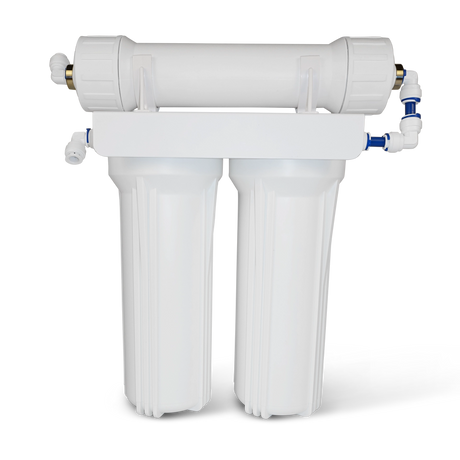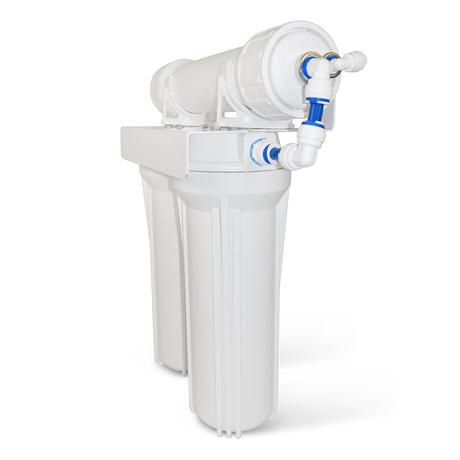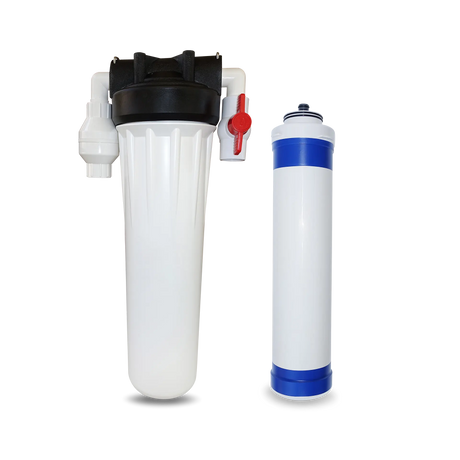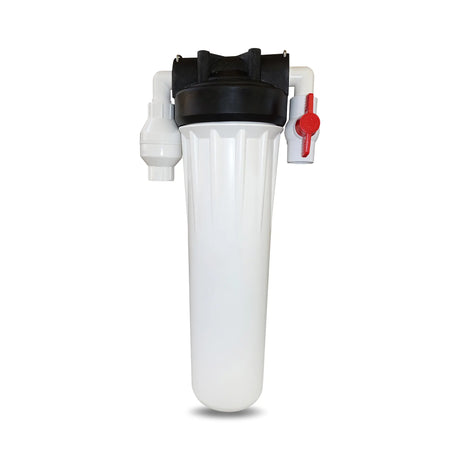Let's Talk Total Dissolved Solids (TDS): What is TDS in Water?
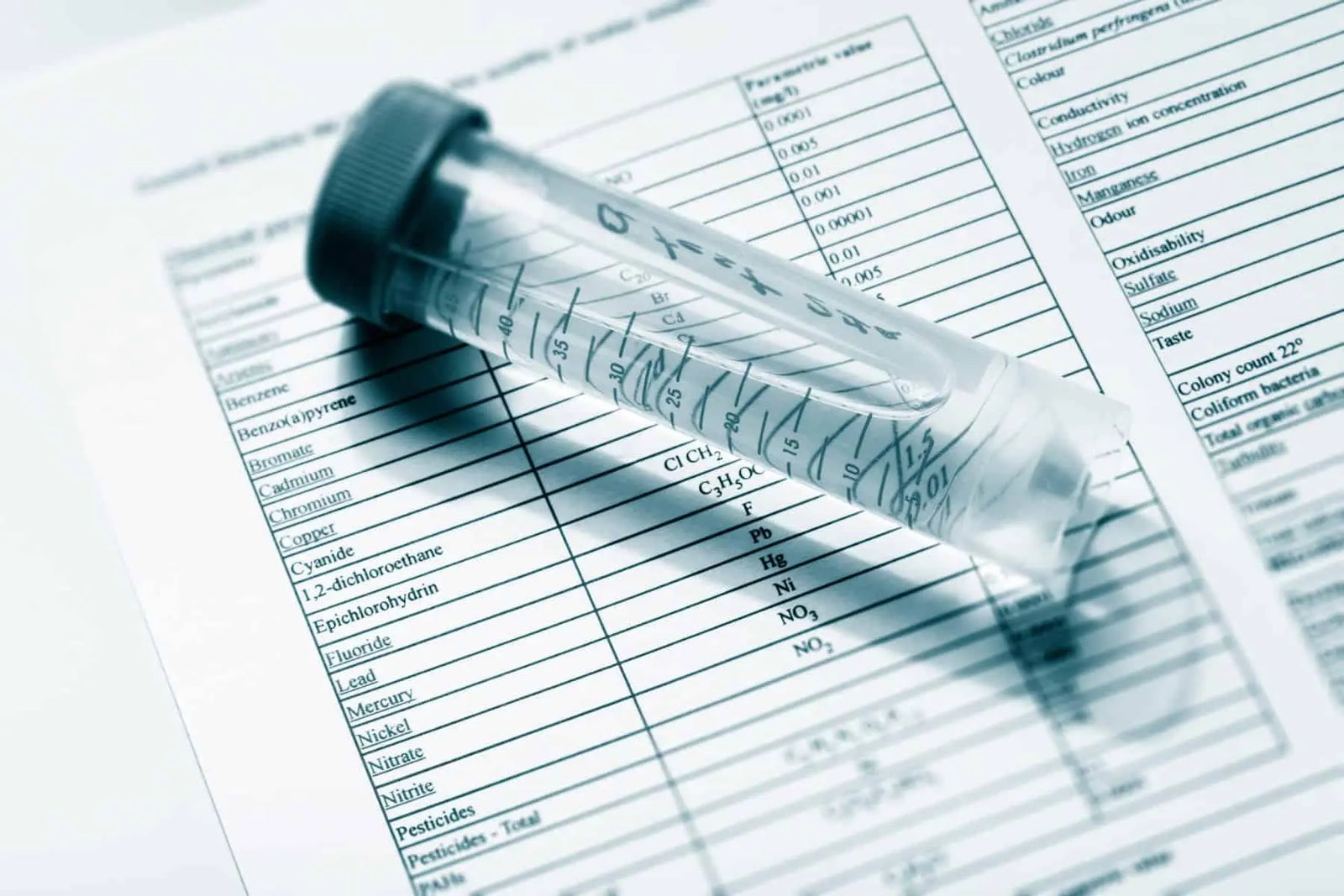
Total dissolved solids - also known as "TDS" - is terminology often used in water filtration, especially in regards to reverse osmosis. Total dissolved solids are the concentration of combined minerals, salts, metals, and dissolved substances in water. There is "good" TDS such as minerals that improve the health and taste of water. There is "bad" TDS like lead, arsenic, pharmaceuticals, and more. A TDS meter does not tell you which total dissolved solids are in your water, and therefore does not indicate if it's healthful TDS or harmful TDS. If your water is known to be free from harmful contaminants, a TDS level of 300 - 500 ppm is the ideal amount of TDS to have in drinking water. In this article, we'll look at what is TDS in water, how to measure it, and what it all means. There are also some misconceptions surrounding TDS in water so we'll also clear those up too.
Jump to:
- What is TDS in water?
- What's the best TDS level for drinking water?
- How to measure TDS
- Ways to Reduce or Remove TDS
- Misconceptions about TDS
What is TDS in water?
All natural water contains minerals and dissolved substances. Minerals are not harmful in drinking water - they're healthful in fact - but other dissolved substances are harmful. Total dissolved solids (TDS) are the concentration of these minerals, salts, metals, and dissolved substances in water. TDS is usually naturally occurring minerals and inorganic salts such as calcium, magnesium, potassium, sodium, carbonates, bicarbonates, chlorides and sulfates. However, TDS also includes lead, mercury, arsenic, pharmaceuticals, hormones, nitrates from fertilizers, pesticides, herbicides, and insecticides. With nearly 80,000 chemicals used in everyday life, there could be a variety of TDS contaminants in your water.TDS can come from quite a few sources including natural ones and as a result of human activities. For example, spring water may have high levels of dissolved solids because it flows through a region where the rocks have a high salt content. Or, in some areas like the prairies of North America there may be high levels of dissolved solids due to high amounts of calcium and magnesium in the ground.
In terms of human activities, agriculture runoff and wastewater discharges can carry excess contaminants into water sources. The salt used to de-ice roads can also impact water sources. When pharmaceuticals are improperly disposed of down the toilet or drain, this impacts drinking water quality and TDS count. We'll discuss it later on as well, but it's important to highlight that TDS meters are both a blessing and a curse. A TDS meter does not distinguish between "good" TDS like minerals that improve the health and taste of water, and "bad" TDS like lead and arsenic.Optimal TDS Levels for Safe and Healthy Drinking Water
The ideal TDS level depends on which total dissolved solids they are. As addressed above, there are minerals and dissolved substances (collectively TDS) that are not harmful - they're healthful in fact - but some dissolved substances are very harmful. There is a big difference in water quality that has a TDS reading of 450 ppm due to naturally occurring/healthful minerals, and water that has a TDS reading of 450 ppm due to the presence of lead. Another consideration is the level of dissolved solids in water. Minerals in drinking water are beneficial to your health but when too much or too little of them are present, it's not ideal. The perfect amount of TDS in drinking water is 300 - 500 ppm if the TDS is naturally occurring, healthful minerals like calcium, potassium, and magnesium. Although the EPA does not federally enforce the guideline, they suggest that community water systems should contain 500 mg/L (500 ppm) or less of total dissolved solids.- Low TDS (<50 - 300 ppm): missing some or all of the minerals that are beneficial to your health
- Excellent TDS (300 - 500 ppm): sweet spot for TDS in drinking water
- Fair TDS (500 - 1,000 ppm): consider an appropriate filtration system to lower your TDS
- Poor TDS (1,000 - 1,999 ppm): not recommended or safe, use an appropriate filtration system to lower your TDS
- Unacceptable TDS (> 2,000 ppm): Any TDS level above 2000 ppm is wholly unsafe; household filters can not handle this level of contamination
How to Accurately Measure TDS in Drinking Water
A TDS meter is the easiest way to measure for total dissolved solids. Some reverse osmosis systems even have a TDS meter built in to monitor the levels. Unfortunately a TDS meter is not going to tell you which total dissolved solids are present in your water, but it's a good starting point to know if you should be concerned about your water. A TDS meter will also indicate if your reverse osmosis system is working as it should. If your water comes from a municipal source, you can a request a water report from your water provider which will include the TDS level of your water. Keep in mind that the report will not explain the reasons for high TDS that are specific to your house (i.e., corroded pipes). Total dissolved solids (TDS) is measured as a volume of water: milligrams per liter (mg/L) or parts per million (ppm) which are one-in-the-same.Effective Ways to Reduce or Remove TDS from Drinking Water
Reverse osmosis is the most comprehensive and popular way to remove and/or reduce TDS in water. Reverse osmosis eliminates nearly all TDS, or at least should reduce it to a very low level (< 50ppm). If your TDS is above 500 ppm this will be the best method of water treatment to reduce or remove TDS from your water. If your TDS is above 2,000 ppm, a household RO system will not be able to handle this high level and you will need something more powerful. A TDS level above 2,000 ppm is completely unsafe to use or drink. Keep in mind, a TDS reading does not indicate which dissolved solids are present. TDS is most likely minerals, but if you have an issue like odor or spots on your fixtures, you should investigate further to see what type of substance is causing the problem. A home water test kit can help with this. Ultimately, the more you know about the makeup of your water, the better you can identify a water filtration system to solve your issues. Alternatively, you can also use a water distiller or deionization (DI) system to completely remove TDS. Deionization is the only purification process that will deliver a true 0 TDS level. Ultrafiltration might reduce TDS, but it's not intended to and depends on which total dissolved solid it is, the concentration, and other variables. Needless to say, do not expect ultrafiltration to remove or reduce any TDS. One of the main benefits of ultrafiltration is that it maintains healthful minerals (TDS). Ultrafiltration is also not intended for really high TDS levels (over 500 ppm) - additional water treatment may be required. Any TDS reduction with ultrafiltration is contaminant specific, or due to fluctuations in TDS levels in the incoming water. One hypothetical example of when it may reduce TDS could be if the incoming water contains lead; ultrafiltration does remove lead particulates and if you also have a lead reducing post-filter on your ultrafiltration system, the dissolved solid level might be reduced. If the TDS in your water is due to naturally occurring minerals, there will be no change in the TDS. Again, don't get ultrafiltration if your goal is to reduce or remove TDS - go with a reverse osmosis or DI system.Common Misconceptions About TDS in Drinking Water
" TDS is a measure of water quality. "
The total dissolved solid level alone is not a measure of water quality. TDS measures the level of dissolved solids in your water- it does not measure anything else. Drinking water quality should be determined based on a variety of indicators such as:- Microorganisms - Cryptosporidium, Giardia lamblia, Legionella, Total Coliforms (including fecal coliform and E. Coli), turbidity, viruses
- Disinfectants - Bromate, Chlorite, Haloacetic acids, Total Trihalomethanes (TTHMs)
- Disinfection byproducts - Chloramines, Chlorine, Chlorine dioxide
- Inorganic chemicals - Arsenic, Asbestos, Barium, Beryllium, Cadmium, Chromium, Copper, Cyanide, Fluoride, Lead, Mercury, Nitrate, Nitrite,
- Organic chemicals - Benzene, Benzo(a)pyrene (PAHs), Carbon tetrachloride, Polychlorinated biphenyls (PCBs)
- Radionuclides - Uranium, Alpha and Beta particles
- Other contaminants / factors - pH, TDS, sediment, Iron, manganese, tannins
" My TDS level is not close to zero...my system isn't working. "
It's a huge misconception that if a TDS reading is not very close to zero, their filtration system isn't working or that it's inefficient. You must consider what type of filtration you have! Monitoring TDS levels is most helpful if you have a reverse osmosis system. Reverse osmosis is intended to take nearly everything out of the water including naturally occurring minerals (TDS). You would expect to see a very low TDS level with a reverse osmosis system (< 50ppm). If you take a TDS reading and it's not very low, it indicates that your reverse osmosis system may not be functioning properly and/or needs a filter or membrane change. If you have an ultrafiltration system, one of the benefits of this style of filtration is that it keeps healthful minerals in your water. As a result there will be a healthy level of TDS in your water. A lot of folks make the switch from a reverse osmosis system to an ultrafiltration one and panic when the TDS reading is not close zero, or around the TDS level their RO system provided. A reverse osmosis system should be removing everything including the minerals; ultrafiltration retains healthful minerals. Remember that the perfect amount of TDS in drinking water is 300 - 500 ppm (assuming the TDS count is due to minerals). Ultrafiltration may reduce TDS if it's harmful contaminants that comprise the TDS level, but ultrafiltration will not remove all TDS. Ultrafiltration does not add minerals to water either, it maintains what's already in there. Keep in mind that if your incoming water has more than 500 ppm TDS, ultrafiltration is not recommended. Routine testing for TDS can provide assurance that your RO system is working like it should. If you have a reverse osmosis system, the TDS level should remain low (<50ppm). If you have an ultrafiltration system, your TDS will depend on your incoming water. You can monitor TDS to check that it's within the healthful range (up to 500 ppm), but a spike in TDS levels will be due to more TDS in your incoming water. Rest assured that ultrafiltration removes harmful contaminants and retains minerals; however a TDS meter reading is not indicative of whether the system is working or not like you would be able to determine with an RO system." Any TDS is bad. "
There's also a misunderstanding that any TDS level except an extremely low amount is bad. Like discussed above, having some TDS in your water (if it's minerals) is beneficial to health and taste. The ideal amount of TDS in drinking water is 300 - 500 ppm. Some folks panic if their TDS level is not close to zero. There is absolutely no reason to panic from a health standpoint if your TDS is 500 ppm or lower. Low TDS also may cause your water to have a flat taste. If you you have a reverse osmosis system you should expect to see a very low TDS level (< 50ppm) because the system should be removing virtually everything in the water. If you take a TDS reading and it's not very low, it means that your reverse osmosis system may need a filter or membrane change, or is not working correctly. Some opt for reverse osmosis filtration because they prefer the taste of having virtually nothing in their water, while some prefer to keep some natural minerals in their water. High levels of TDS affects the taste of your drinking water. Depending on the type of dissolved solid, water could cause a bitter, salty, or even a sulfuric taste or odor.

